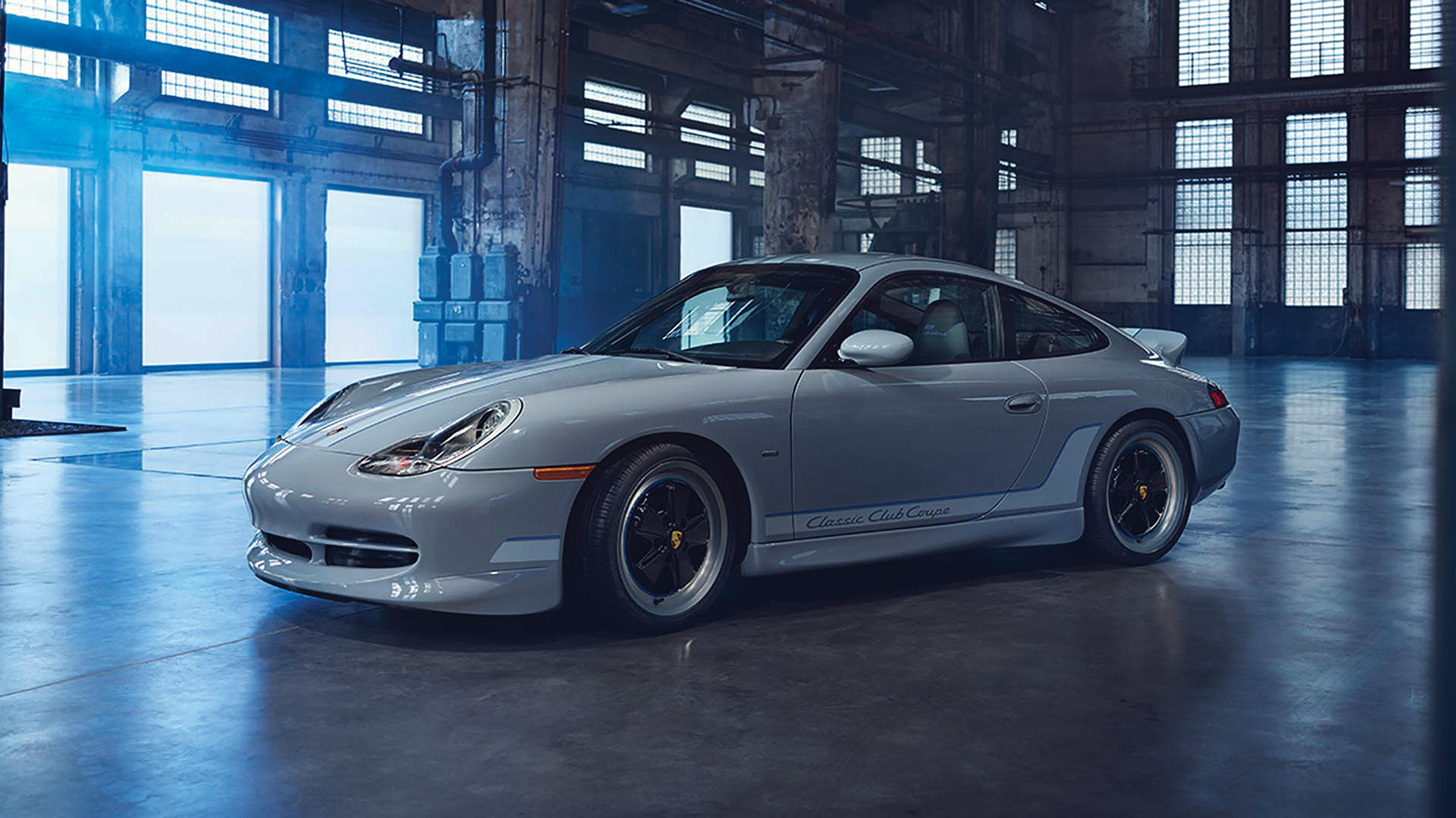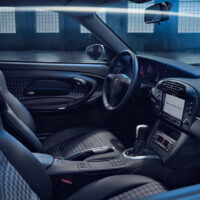Built as a factory one-off, the 911 Classic Club Coupe marks the first one-off within the Sonderwunsch (special wish) program that is a classic vehicle.
Upon arrival, the Carrera was completely stripped of its component parts and treated to a chemical bath, removing all layers of paint. The underbody, placed on a frame-straightening bench, was precisely measured and reshaped to return it to production specification, reaching the “Body-in-White” phase once complete. Deeply invested in the build process, Porsche constructed a test vehicle to evaluate and tweak the aerodynamics of the design at the Weissach development-center wind tunnel.
Armed with this knowledge, the production and assembly process by Porsche Classic could begin in earnest with much of the bodyshell reworked and reinforced to suit the new components — many of which were sourced from GT3 models.
Today, the Classic Club Coupe features under 300 miles at cataloging and remains in “as delivered” condition, a fitting tribute to the early ideas from Porsche Classic and those who dared to dream big at Porsche Club of America.
SCM Analysis
Detailing
| Vehicle: | 1999 Porsche 911 Classic Club Coupe “Sonderwunsch” |
| Years Produced: | 1999–2004 |
| Number Produced: | 175,250 (1 Classic Club Coupe) |
| Tune Up Cost: | $1,500 |
| Chassis Number Location: | Tag in front trunk, windshield tag, tag on driver’s side door jamb |
| Engine Number Location: | On stand under fan — requires cable scanner/camera to view |
| Club Info: | Porsche Club of America |
| Website: | http://www.pca.org |
| Alternatives: | 2004 Porsche 996 GT3 RS; 2012–22 Singer Classic; 2004–05 Porsche Carrera GT |
This car, Lot 232, sold for $1,325,000, including buyer’s premium, at Broad Arrow Auctions’ Atlanta, GA, sale on June 10, 2023.
Porsche Cars North America (PCNA), Porsche AG (PAG), and the Porsche Club of America (PCA) have a 20-year history of cooperating on four projects that included PCA design involvement and often PCA identification on the car.
Club collaborations
The first undertaking was the 2006 997.1 Club Coupe, the result of an effort headed by PCA’s then-President Tom Bobbitt to celebrate PCA’s 50th anniversary. Porsche produced a 3.8-liter Carrera S with a X51 Power Kit that delivered 381 horsepower and 306 lb-ft of torque through a 6-speed manual gearbox. Porsche added special trim features, 19-inch Sport Design wheels, and painted all the cars in a special color, Azzurro California Blue Metallic. A drawing of interested PCA members determined who could buy one. MSRP was $103,300 with as-delivered prices of $105,000–$115,000; 50 Club Coupes were built and one was retained by PAG for its museum. Your author has #29 of the 49 sold to Club members. It’s a very fine car.
A couple of years later, Porsche Classic and PCA cooperated again to find a long-hood 911 and restore it to original condition. A Los Angeles-sourced and mostly rust-free metallic silver 1973 911T was the car. Fully restored by Porsche Classic in Stuttgart and shown at PCA and other events afterwards, it was the prize in a PCA raffle and went to a Club member in 2011.
Next was the 2016 Carrera GTS Club Coupe in Club Blau paint (dark non-metallic blue), of which 60 examples were built to commemorate PCA’s 60th anniversary. It had a 3.8-liter engine that yielded 430 hp and 325 lb-ft of torque, delivered through a PDK or a manual gearbox. It rode on distinctive flat-spoke 20-inch Sport Classic wheels. MSRP was $136,000 and delivered prices were typically over $150k.
Refried eggs
As Porsche AG edged toward its 2023 75th Anniversary year, another project was proposed. Four years ago, PCA’s leaders and representatives from PCNA, PAG and Porsche Classic brainstormed plans. The 996 had been out of production for more than 10 years and was now under Classic’s auspices. The mission was to buy a worn-out 1999–2004 Type 996, restore it with substantial upgrades in mechanicals, appearance and trim, and make it one of a kind. PCA National Director Vu Nguyen found a donor car at a Porsche dealer in nearby Arlington, VA, and the project was on.
A common thread through all joint PCA-Porsche projects has been well-known Porsche designer Grant Larson. Joining him on this project was Exclusive Manufaktur chief Boris Apenbrink along with Porsche Classic’s Alexander Fabig and Uwe Makrutzki, two terrific people to work with. (I know firsthand.) This 996 was “reimagined” in Porsche Classic’s facilities in Stuttgart.
The project took the later 2010 997.2 Sport Classic, built 250 strong, as its inspiration. That model was not sold in North America. In 2013, DOT approved Show or Display for the model, and thereafter perhaps a dozen were imported — that few because EPA federalization has been frightfully expensive. The team thought a Sport Classic “reimagining” to be a strong approach, so that aesthetic, with double-bubble roof and reinterpreted 1973 RS ducktail, was used.
Only the body shell was kept from the 1999 donor car. Porsche Classic built up the tub from scratch, starting with the factory’s production-line anti-corrosion “bath.” They touched every part on the car. The mechanicals were brand-new issues of 996.2 GT3 components including a 3.6-liter flat-6 engine with 381 hp and an 8,000-rpm redline, delivered through a 6-speed manual gearbox. The interior was heavily customized with lots of leather, special seats and instruments, custom sill plates, etc. The paint was a new color, Sport Gray Metallic, close to the 2010 color.
The team kept the distinctive ovaloid “fried egg” headlamps, a much-maligned visual identifier of the 996. Their reasoning was to draw fresh attention to the 996, Porsche’s first water-cooled 911. It has historically ranked low in interest from drivers, collectors, and perhaps nearly everyone except race-car builders looking for donor tubs. The team wanted to help change the model’s reception with publicity for this special car.
That publicity came in large waves. The car was introduced at the Amelia Island weekend’s Werks Reunion and The Amelia concours in March 2022. Afterwards came a year of expansive press coverage. With Jerry Seinfeld’s $1,325,000 purchase at Broad Arrow’s Atlanta auction, more huge media coverage ensued.
All the cooperating parties were thrilled with the reception of the car, that Seinfeld bought it, and the price realized. Under Porsche’s reborn Sonderwunsch (aka “Special Wishes”) program, Porsche will make a unique car on a new model or an old one. The result here bodes well for that endeavor. Other manufacturers are doing similar projects. It’s a low-volume niche market, but the profit per car is probably handsome.
What’s the market impact?
My SCM editor likes to ask the tough question: “What will be the market impact of the Classic Club Coupe sale for regular 996s?” I am going to guess slight.
The 996 is a good car and has been a used Porsche bargain for years — the entry-level 911 for many people. Once the intermediate-shaft-bearing issue has been dealt with ($2k–$4k — and often already done, these days), the cars are reliable drivers, make good track-day cars, and feel like proper 911s. Like the 964 used-car bargain before it, 996 values will rally over time, but I’d guess on a more gently sloped curve. As of now, there are no Singers, Gunther Werks, etc., to drive up prices for used 996s. How long will it continue to be difficult to love the shared Boxster headlights and the Toyota-ized interiors?
With more than 175,000 996s built, they will never be rare and IMS bearings will continue to be discussed for non-GT2, GT3 and Turbo variants without the “Mezger engine.” Only the homologation-model 2004 GT3 RS (682 manufactured) will likely be truly valuable, while 996 GT2s (1,214 worldwide) will be mildly collectible and 996 GT3s (4,457 worldwide) will be desirable drivers. The 996 Turbos (20,375 built plus 1,563 Turbo S) have likely exited the appreciation corner (at rates above inflation), and normally aspirated 996s are probably at entry turn-in. ©
(Introductory description courtesy of Broad Arrow Auctions.)



